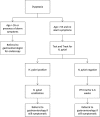Helicobacter pylori: evidence-based review with a focus on immigrant populations
- PMID: 24065381
- PMCID: PMC3930769
- DOI: 10.1007/s11606-013-2630-y
Helicobacter pylori: evidence-based review with a focus on immigrant populations
Abstract
Helicobacter pylori has been causally linked to a number of diseases, including peptic ulcer disease, gastric adenocarcinoma, mucosa-associated lymphoid tissue lymphoma, and dyspepsia. It is the most prevalent bacterial pathogen in humans, and while the overall prevalence in the United States is about 30 %, the distribution is heterogeneous amongst different ethnic groups. Recent immigrants from high prevalence areas such as Korea, Japan, and China bear an increased burden of its disease and complications. There is clear evidence that treatment of H. pylori resolves peptic ulcer disease, and increasing evidence for protection against development of gastric adenocarcinoma. However, H. pylori treatment failure is common and alternative regimens may be necessary. The following case-based review will highlight these issues, including the epidemiology of H. pylori in the immigrant population, an approach to dyspepsia, and the role of H. pylori in gastric adenocarcinoma.
Figures



References
Publication types
MeSH terms
Grants and funding
LinkOut - more resources
Full Text Sources
Other Literature Sources
Medical

